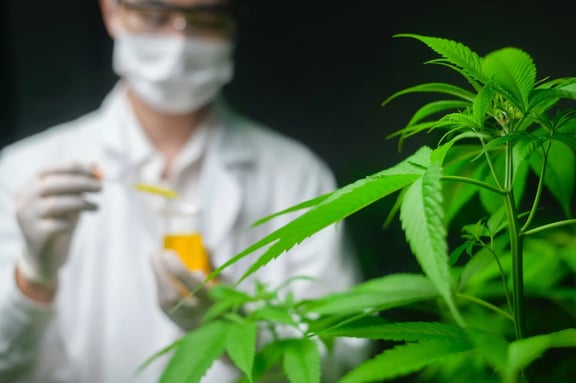Terpene Lowdown
Myrcene Flavours
Sweet
Purple Grape
Earthy
Musky
Herbal

Introduction
In the expansive and often mesmerising world of cannabis, various components play integral roles in shaping the user’s experience. Among these, terpenes stand as unsung heroes, orchestrating an orchestra of effects, aromas, and flavours that make each strain unique. One terpene that often shies away from the limelight, yet holds a pivotal position, is Myrcene. This common terpene doesn’t just stop at lending its character to cannabis but traverses beyond, finding its essence in many everyday flora. The journey from the roots of Myrcene to its implications for health and the broader botanical spectrum unveils an element that’s as commonplace as it is remarkable.
Unveiling Myrcene: A Common Yet Pivotal Terpene
Myrcene, bearing the scientific name Beta Myrcene, is a monoterpene, signifying its simpler structure amongst the terpene family. But don’t let the simplicity fool you. Myrcene is distinctive in the wide array of terpenes, thanks to its characteristic profile and ubiquitous presence in the plant kingdom.
Myrcene exists in two isomeric forms, namely β-myrcene (7-methyl-3-methylene-1,6-octadiene) and α-myrcene (2-methyl-6-methylene-1,7-octadiene). The most common is the naturally occurring isomer β-myrcene, which contains an isopropylidene group and is often denoted as “myrcene” in the literature. The other is α-myrcene, which exists in the isopropenyl form. [1] In β-myrcene there are three carbon-carbon double bonds (two of them being conjugated) and a gem-dimethyl terminal.[2].
The Nature of Myrcene
Origin and Natural Occurrences
Tracing the origins and natural occurrences of Myrcene leads us to a variety of botanical realms. This terpene doesn’t confine itself to the cannabis plant but ventures out, marking its presence in an array of other plants, each of which, interestingly, is known for its distinctive aroma and flavour profile. Whether it’s the citrusy whiff of lemongrass or the spicy kick of wild thyme, Myrcene is there, laying down the aromatic foundation.
Aroma Characteristics: The Earthy Signature
Dive into the aroma profile of Myrcene, and you’re enveloped in an earthy, musky scent with a hint of citrus. It’s this very aroma that often acts as the first clue to the presence of Myrcene in a plant. The earthy signature, often reminiscent of the damp soil after a rain, is what makes Myrcene a key player in the aromatic profiles of many plants, not to mention its significant role in the scent profiles of various cannabis strains.
Myrcene in Cannabis
Prevalence in Different Strains
Venture into the world of cannabis, and you’ll soon realise the prevalence of Myrcene in many beloved strains. This terpene doesn’t just stop at lending its aroma; it goes further, influencing the effects of the strain on the user. Myrcene’s concentration often categorises a strain as either indica strains or sativa strains, with higher levels generally associated with the former.
The Entourage Effect: Myrcene’s Synergistic Play
The tale of Myrcene in cannabis gets even more intriguing when delving into its role in the entourage effect. This phenomenon refers to the synergistic play of cannabinoids and terpenes, enhancing the overall effect of cannabis. Myrcene, with its ability to modulate the effects of other cannabinoids, stands as a significant player in this synergistic dance, amplifying the therapeutic and recreational attributes of cannabis.
Identifying High-Myrcene Strains
Identifying high-Myrcene medical cannabis strains isn’t merely a chase for the earthy aroma. It’s about tuning into a particular vibe that such strains exude. Engaging with growers and dispensaries or relying on lab-tested products can aid this quest. The higher Myrcene content often translates to a more sedative or ‘couch-lock’ effect, making the identification worthwhile for those seeking a calming experience.
Now, as we traverse further into the Myrcene spectrum we’ll delve into its presence beyond cannabis, exploring the terpene’s rendezvous with hops, beer crafting, and the healthful promises it holds.
Beyond Cannabis: Myrcene’s Broad Spectrum
Myrcene in Hops and Beer Crafting

Hops and cannabis share more than just a taxonomic family; they share the terpene Myrcene, a common thread in their aromatic tapestry. The crafting of beer is an age-old tradition, and the use of hops in this craft is central. Myrcene, with its earthy and spicy undertones, contributes to the unique aroma and flavour profile of many beers. The terpene’s presence isn’t just a passive addition; it’s a nuanced contribution that shapes the identity of the brew. It’s the subtle play of Myrcene, among other terpenes, that crafts the characteristic bitterness and aromatic allure of hops, rendering each pint a narrative of botanical interplay.
From Mangoes to Lemongrass: Diverse Sources of Myrcene
The journey of Myrcene doesn’t stop at hops or cannabis; it traverses further into the botanical realm, finding its essence in a medley of plants. Mangoes, a fruit loved by many, hold a significant amount of Myrcene. This terpene contributes to the fruit’s unique aroma and is believed to accentuate the effects of cannabis when consumed together. Similarly, lemongrass, known for its citrusy zest, is another proud carrier of Myrcene. The terpene’s presence is believed to contribute to the traditional use of lemongrass in calming teas and holistic remedies.
The Healthful Promises of Myrcene
Anti-inflammatory Potential
Myrcene’s tale extends beyond its aromatic contributions, venturing into the realm of therapeutic potential. The terpene has shown promise in combating inflammation, a common ailment plaguing many. The anti-inflammatory potential of Myrcene could herald a natural way to alleviate discomfort, marking a step towards harnessing nature’s bounty for better health.
Analgesic Properties: A Natural Pain Reliever?
The whispers of Myrcene’s analgesic properties have caught the attention of those in pursuit of natural pain relief solutions. Although the research landscape is still burgeoning, the initial findings paint a hopeful picture. The analgesic potential could position Myrcene as a natural ally in combating pain, a prospect that warrants deeper exploration.
Anti-tumor Prospects
The anti-tumour prospects of Myrcene add a significant chapter to its narrative. Preliminary studies hint at its potential in combating certain types of cancer cells, although the journey of scientific validation is long and winding. Yet, the glimmer of hope remains, urging the scientific community to delve deeper into Myrcene’s potential.
Antioxidant Benefits: A Shield Against Free Radicals
The antioxidant prowess of Myrcene unveils a shield against the onslaught of free radicals, molecules known for their role in ageing and disease. Myrcene’s antioxidant benefits could represent a natural fortress against oxidative stress, a common culprit behind many chronic ailments.
Sedative Effects: Calming the Storm
The calming, sedative effects associated with Myrcene echo through the annals of folk medicine. The terpene’s potential to promote relaxation and sleep could be a boon for those wrestling with the relentless pace of modern life.
The myriad healthful promises of Myrcene sketch a narrative that’s as intriguing as it is promising. The terpene’s journey from the heart of nature to the precipice of scientific inquiry beckons a deeper understanding, urging us to explore the uncharted territories that lie ahead. As we venture further into the scientific inquiries and future directions, the tale of Myrcene unfolds a panorama of possibilities awaiting exploration.
Scientific Inquiries and Future Directions

Current Research Landscape
The current research landscape surrounding Myrcene paints a picture of curiosity mingled with anticipation. While the terpene has been a subject of interest due to its prevalence in cannabis and other botanicals, the scientific inquiry into its therapeutic potential is relatively nascent. The existing studies have shed light on its anti-inflammatory, analgesic, and potential anti-tumour properties, yet the depth of understanding desired necessitates more rigorous investigations. The studies so far have mainly been conducted in vitro or in animal models, and the extrapolation of these findings to human health remains a significant leap.
Example Studies
Myrcene’s potential as an anti-inflammatory agent has been examined in the context of osteoarthritis, a debilitating joint condition. In a study, myrcene and limonene were found to inhibit certain inflammatory responses triggered by IL-1β in human chondrocytes. Myrcene notably impeded nitric oxide production, a reactive molecule associated with inflammatory processes. Furthermore, it suppressed the activation of inflammatory pathways and the expression of inflammatory genes while promoting the expression of anti-catabolic genes, suggesting a potential protective role against osteoarthritis-related cartilage degradation. [3]
Another study demonstrated myrcene’s potential anti-inflammatory attributes in a model of renal inflammation. In adrenalectomized (ADX) rats, myrcene treatment downregulated the levels of pro-inflammatory cytokines IL-6, IL-1β, and TNF-α compared to untreated ADX rats, underscoring myrcene’s anti-inflammatory effect on renal inflammation.[4]
Uncharted Territories: What More to Uncover?
The uncharted territories of Myrcene’s research beckon with the promise of unveiling a deeper understanding of this common yet intriguing terpene. The potential interactions of Myrcene with other cannabinoids and terpenes, its precise mechanism of action, and the full spectrum of its health benefits are among the myriad facets awaiting exploration. Moreover, the potential of Myrcene in pharmaceutical applications, its safety profile, and the optimal dosages for therapeutic efficacy are questions that remain largely unanswered. As the curtain of scientific inquiry lifts gradually, the hope is to unveil the holistic picture of Myrcene’s impact on health and wellbeing.
The Multifaceted Realm of Myrcene: A Recapitulation
As we traverse back through the realms explored, the multifaceted narrative of Myrcene unfolds as a blend of botanical essence, aromatic allure, therapeutic promise, and a beacon of scientific curiosity. From the earthy whispers of cannabis to the zesty embrace of lemongrass, Myrcene weaves a tapestry of natural wonder. Its potential to alleviate pain, combat inflammation, and possibly even stand against the ominous shadow of cancer, sketches a narrative of hope. The entwined paths of Myrcene with other terpenes and cannabinoids in the entourage effect hint at a broader spectrum of therapeutic potential, urging a deeper dive into the terpene synergy.
The journey from the heart of nature to the precipice of scientific discovery in the Myrcene exemplifies the profound connection between the botanical world and human well-being. As the scientific community ventures further into the mysteries shrouding Myrcene, the anticipation is to unveil a narrative that’s not only fascinating but holds a promise of better health, a deeper understanding of cannabis, and a broader appreciation of the natural world. The tale of Myrcene is a testament to the boundless curiosity and the relentless pursuit of understanding that characterises the human spirit, in the quest to unveil the treasures that nature, in its quiet, unassuming manner, lays before us.
The article’s journey unveils Myrcene as a common yet pivotal terpene, with its narrative extending beyond the leafy realms of cannabis into the broader botanical spectrum and the promising horizons of scientific inquiry.
Myrcene Facts
Myrcene is derived mainly semi-synthetically from Myrcia, lending it its name.
Commercially produced often via the pyrolysis of β-pinene, sourced from turpentine.
Found in various plants like verbena, wild thyme, cannabis, and mango, among others.
Predominant terpene in modern North American cannabis cultivars.
Undergoes photo-oxidation to form a novel terpene called “hashishene”, abundant in hashish.
Utilized in the perfumery industry as an intermediate, though rarely used directly due to its instability in air. [5]
A significant terpene in hops, with β-myrcene being the largest monoterpene fraction.
Comprises between 29.4% and 65.8% of steam-distilled essential oil in certain Cannabis sativa strains.
Abundant in various international flora like the South African Adenandra Villosa and Brazilian Schinus molle.
Converted to myrcenol, a fragrance found in lavender, through a process involving hydroamination and palladium-catalyzed removal of amine.[6]
Can eating Mangos improve your cannabis high?
It has been said that consuming mangos can enhance the high from cannabis, and this is due to the presence of Myrcene in the mangos, which complements the cannabis.
This topic is explored further on the ISMOKE Website.












.jpg)